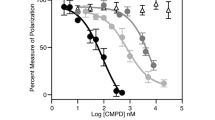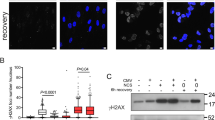Abstract
Checkpoint kinase 1 (Chk1) mediates diverse cellular responses to genotoxic stress, regulating the network of genome-surveillance pathways that coordinate cell cycle progression with DNA repair. Chk1 is essential for mammalian development and viability, and has been shown to be important for both S and G2 checkpoints. We now present evidence that the HTLV-1 Tax protein interacts directly with Chk1 and impairs its kinase activities in vitro and in vivo. The direct and physical interaction of Chk1 and Tax was observed in HTLV-1-infected T cells (C81, HuT 102 and MT-2) and transfected fibroblasts (293 T) by coimmunoprecipitation and by in vitro GST pull-down assays. Interestingly, Tax inhibited the kinase activity of Chk1 protein in in vitro and in vivo kinase assays. Consistent with these results, Tax inhibited the phosphorylation-dependent degradation of Cdc25A and G2 arrest in response to γ-irradiation (IR) in a dose-dependent manner in vivo. The G2 arrest did not require Chk2 or p53. These studies provide the first example of a viral transforming protein targeting Chk1 and provide important insights into checkpoint pathway regulation.
This is a preview of subscription content, access via your institution
Access options
Subscribe to this journal
Receive 50 print issues and online access
$259.00 per year
only $5.18 per issue
Buy this article
- Purchase on Springer Link
- Instant access to full article PDF
Prices may be subject to local taxes which are calculated during checkout







Similar content being viewed by others
References
Abraham RT . (2001). Genes Dev., 15, 2177–2196.
Akagi T, Ono H, Tsuchida N and Shimotohno K . (1997). FEBS Lett., 406, 263–266.
Anderson CW, Appella E and Sakaguchi K . (1998). J. Protein Chem., 17, 527.
Ariumi Y, Ego T, Kaida A, Matsumoto M, Pandolfi PP and Shimotohno K . (2003). Oncogene, 22, 1611–1619.
Ariumi Y, Kaida A, Lin JY, Hirota M, Masui O, Yamaoka S, Taya Y and Shimotohno K . (2000). Oncogene, 19, 1491–1499.
Bartek J and Lukas J . (2003). Cancer Cell, 3, 421–429.
Bex F and Gaynor RB . (1998). Methods, 16, 83–94.
Brown AL, Lee CH, Schwarz JK, Mitiku N, Piwnica-Worms H and Chung JH . (1999). Proc. Natl. Acad. Sci. USA, 96, 3745–3750.
Bunz F, Dutriaux A, Lengauer C, Waldman T, Zhou S, Brown JP, Sedivy JM, Kinzler KW and Vogelstein B . (1998). Science, 282, 1497–1501.
Burton M, Upadhyaya CD, Maier B, Hope TJ and Semmes OJ . (2000). J. Virol., 74, 2351–2364.
Canman CE, Lim DS, Cimprich KA, Taya Y, Tamai K, Sakaguchi K, Appella E, Kastan MB and Siliciano JD . (1998). Science, 281, 1677–1679.
Cereseto A, Diella F, Mulloy JC, Cara A, Michieli P, Grassmann R, Franchini G and Klotman ME . (1996). Blood, 88, 1551–1560.
Chen Z, Xiao Z, Chen J, Ng SC, Sowin T, Sham H, Rosenberg S, Fesik S and Zhang H . (2003). Mol. Cancer Ther., 2, 543–548.
Clifford B, Beljin M, Stark GR and Taylor WR . (2003). Cancer Res., 63, 4074–4081.
Coscoy L, Gonzalez-Dunia D, Tangy F, Syan S, Brahic M and Ozden S . (1998). Virology, 248, 332–341.
Feijoo C, Hall-Jackson C, Wu R, Jenkins D, Leitch J, Gilbert DM and Smythe C . (2001). J. Cell Biol., 154, 913–924.
Franchini G . (1995). Blood, 86, 3619–3639.
Gartenhaus RB and Wang P . (1995). Leukemia, 9, 2082–2086.
Gatei M, Sloper K, Sorensen C, Syljuasen R, Falck J, Hobson K, Savage K, Lukas J, Zhou BB, Bartek J and Khanna KK . (2003). J. Biol. Chem., 278, 14806–14811.
Gatei M, Zhou BB, Hobson K, Scott S, Young D and Khanna KK . (2001). J. Biol. Chem., 276, 17276–17280.
Grassmann R, Berchtold S, Radant I, Alt M, Fleckenstein B, Sodroski JG, Haseltine WA and Ramstedt U . (1992). J. Virol., 66, 4570–4575.
Grassmann R, Dengler C, Muller-Fleckenstein I, Fleckenstein B, McGuire K, Dokhelar MC, Sodroski JG and Haseltine WA . (1989). Proc. Natl. Acad. Sci. USA, 86, 3351–3355.
Grossman WJ, Kimata JT, Wong F, Zutter M, Ley TJ and Ratner L . (1995). Proc. Natl. Acad. Sci. USA, 92, 1057–1061.
Guerra B, Issinger OG and Wang JY . (2003). Oncogene, 22, 4933–4942.
Haoudi A, Daniels RC, Wong E, Kupfer G and Semmes OJ . (2003). J. Biol. Chem., 278, 37736–37744.
Haoudi A and Semmes OJ . (2003). Virology, 305, 229–239.
Heffernan TP, Simpson DA, Frank AR, Heinloth AN, Paules RS, Cordeiro-Stone M and Kaufmann WK . (2002). Mol. Cell. Biol., 22, 8552–8561.
Hirao A, Kong YY, Matsuoka S, Wakeham A, Ruland J, Yoshida H, Liu D, Elledge SJ and Mak TW . (2000). Science, 287, 1824–1827.
Hollsberg P . (1999). Microbiol. Mol. Biol. Rev., 63, 308–333.
Jallepalli PV, Lengauer C, Vogelstein B and Bunz F . (2003). J. Biol. Chem., 278, 20475–20479.
Jeang KT, Derse D, Matocha M and Sharma O . (1997). J. Virol., 71, 6277–6278.
Jeang KT, Widen SG, Semmes OJ and Wilson SH . (1990). Science, 247, 1082–1084.
Johnson JM, Harrod R and Franchini G . (2001). Int. J. Exp. Pathol., 82, 135–147.
Kaneko YS, Watanabe N, Morisaki H, Akita H, Fujimoto A, Tominaga K, Terasawa M, Tachibana A, Ikeda K, Nakanishi M and Kaneko Y . (1999). Oncogene, 18, 3673–3681.
Kao SY and Marriott SJ . (1999). J. Virol., 73, 4299–4304.
Kasai T, Iwanaga Y, Iha H and Jeang KT . (2002). J. Biol. Chem., 277, 5187–5193.
Lemoine FJ, Kao SY and Marriott SJ . (2000). AIDS Res Hum. Retroviruses, 16, 1623–1627.
Lemoine FJ and Marriott SJ . (2001). J. Biol. Chem., 276, 31851–31857.
Liu Q, Guntuku S, Cui XS, Matsuoka S, Cortez D, Tamai K, Luo G, Carattini-Rivera S, DeMayo F, Bradley A, Donehower LA and Elledge SJ . (2000). Genes Dev., 14, 1448–1459.
Marriott SJ, Lemoine FJ and Jeang KT . (2002). J. Biomed. Sci., 9, 292–298.
Matsuoka S, Huang M and Elledge SJ . (1998). Science, 282, 1893–1897.
Matsuoka S, Rotman G, Ogawa A, Shiloh Y, Tamai K and Elledge SJ . (2000). Proc. Natl. Acad. Sci. USA, 97, 10389–10394.
McGowan CH . (2002). Bioessays, 24, 502–511.
Melchionna R, Chen XB, Blasina A and McGowan CH . (2000). Nat. Cell Biol., 2, 762–765.
Miwa M, Shimotohno K, Hoshino H, Fujino M and Sugimura T . (1984). Gann, 75, 752–755.
Mulloy JC, Kislyakova T, Cereseto A, Casareto L, LoMonico A, Fullen J, Lorenzi MV, Cara A, Nicot C, Giam CZ and Franchini G . (1998). J. Virol., 72, 8852–8860.
Philpott SM and Buehring GC . (1999). J. Natl. Cancer Inst., 91, 933–942.
Pise-Masison CA, Choi KS, Radonovich M, Dittmer J, Kim SJ and Brady JN . (1998a). J. Virol., 72, 1165–1170.
Pise-Masison CA, Mahieux R, Jiang H, Ashcroft M, Radonovich M, Duvall J, Guillerm C and Brady JN . (2000). Mol. Cell. Biol., 20, 3377–3386.
Pise-Masison CA, Mahieux R, Radonovich M, Jiang H and Brady JN . (2001). J. Biol. Chem., 276, 200–205.
Pise-Masison CA, Radonovich M, Sakaguchi K, Appella E and Brady JN . (1998b). J. Virol., 72, 6348–6355.
Poiesz BJ, Ruscetti FW, Gazdar AF, Bunn PA, Minna JD and Gallo RC . (1980). Proc. Natl. Acad. Sci. USA, 77, 7415–7419.
Robek MD and Ratner L . (1999). J. Virol., 73, 4856–4865.
Saka Y, Esashi F, Matsusaka T, Mochida S and Yanagida M . (1997). Genes Dev., 11, 3387–3400.
Semmes OJ and Jeang KT . (1996). J. Virol., 70, 6347–6357.
Shieh SY, Ahn J, Tamai K, Taya Y and Prives C . (2000). Genes Dev., 14, 289–300.
Shiloh Y . (2003). Nat. Rev. Cancer, 3, 155–168.
Sorensen CS, Syljuasen RG, Falck J, Schroeder T, Ronnstrand L, Khanna KK, Zhou BB, Bartek J and Lukas J . (2003). Cancer Cell, 3, 247–258.
Sugiyama K, Shimizu M, Akiyama T, Tamaoki T, Yamaguchi K, Takahashi R, Eastman A and Akinaga S . (2000). Int. J. Cancer, 85, 703–709.
Tanaka A, Takahashi G, Yamaoka S, Nosaka T, Maki M and Hatanaka M . (1990). Proc. Natl. Acad. Sci. USA, 87, 1071–1075.
Taylor WR, DePrimo SE, Agarwal A, Agarwal ML, Schonthal AH, Katula KS and Stark GR . (1999). Mol. Biol. Cell, 10, 3607–3622.
Van Orden K, Giebler HA, Lemasson I, Gonzales M and Nyborg JK . (1999). J. Biol. Chem., 274, 26321–26328.
Walworth NC . (2000). Curr. Opin. Cell Biol., 12, 697–704.
Wang Q, Fan S, Eastman A, Worland PJ, Sausville EA and O'Connor PM . (1996). J. Natl. Cancer Inst., 88, 956–965.
Xiao Z, Chen Z, Gunasekera AH, Sowin TJ, Rosenberg SH, Fesik S and Zhang H . (2003). J. Biol. Chem., 278, 21767–21773.
Xu B, Kim St and Kastan MB . (2001). Mol. Cell. Biol., 21, 3445–3450.
Xu B, Kim St, Lim DS and Kastan MB . (2002). Mol. Cell. Biol., 22, 1049–1059.
Yu Q, La Rose J, Zhang H, Takemura H, Kohn KW and Pommier Y . (2002). Cancer Res., 62, 5743–5748.
Zachos G, Rainey MD and Gillespie DAF . (2003). EMBO J., 22, 713–723.
Zhao B, Bower MJ, McDevitt PJ, Zhao H, Davis ST, Johanson KO, Green SM, Concha NO and Zhou BB . (2002a). J. Biol. Chem., 277, 46609–46615.
Zhao H and Piwnica-Worms H . (2001). Mol. Cell. Biol., 21, 4129–4139.
Zhao H, Watkins JL and Piwnica-Worms H . (2002b). Proc. Natl. Acad. Sci. USA, 99, 14795–14800.
Zhou BB and Elledge SJ . (2000). Nature, 408, 433–439.
Acknowledgements
We thank Dr Cynthia Pise-Masison and members of Dr Brady's laboratory for helpful discussion, and the FACS core facility of CCR, NCI, NIH for flow cytometry analysis. We also thank Drs Bert Vogelstein and Fred Bunz for providing HCT116p21+/+, p53−/−, and Chk2−/− cell lines.
Author information
Authors and Affiliations
Corresponding author
Additional information
Supplementary Information accompanies the paper on Oncogene website: (http://www.nature.com/onc).
Supplementary information
Figure S1
Western blot of immunoprecipitates from HTLV-1-transformed C81cell lysates using a polyclonal anti-Chk1 antibody or control IgG antibody for 2-h or overnight incubation. The upper panel shows the coprecipitated Tax level. The lower panel indicates the amount of Chk1 precipitated. IP, immunoprecipitation; o/n, overnight (JPG 87 kb)
Rights and permissions
About this article
Cite this article
Park, H., Jeong, JH., Chung, J. et al. Human T-cell leukemia virus type 1 Tax interacts with Chk1 and attenuates DNA-damage induced G2 arrest mediated by Chk1. Oncogene 23, 4966–4974 (2004). https://doi.org/10.1038/sj.onc.1207644
Received:
Revised:
Accepted:
Published:
Issue Date:
DOI: https://doi.org/10.1038/sj.onc.1207644
Keywords
This article is cited by
-
Identification of dysregulated pathways underlying HTLV-1-associated myelopathy/tropical spastic paraparesis through co-expression network analysis
Journal of NeuroVirology (2021)
-
How the DNA damage response determines the fate of HTLV-1 Tax-expressing cells
Retrovirology (2012)
-
The DNA damage response in viral-induced cellular transformation
British Journal of Cancer (2012)
-
Human T-cell leukemia virus type 1 (HTLV-1) and leukemic transformation: viral infectivity, Tax, HBZ and therapy
Oncogene (2011)



